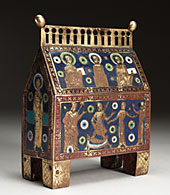 |
Growing
the Museum Collection

The
Judgment of Solomon, a 13th-century reliquary;
artist unknown |
Last year, when Louise Ines
Doyle ’34 gave the Smith College Museum of Art (SCMA)
a sizable monetary gift, director Jessica Nicoll asked Brigitte
Buettner, professor of art history, to go shopping in Paris
for a work of medieval art for the facility's permanent collection.
Buettner found an early 13th-century reliquary made of champlevé enamel
on copper, with a scene of the Judgment
of Solomon. The work was purchased by the museum and will
make its debut in the fall.
The museum’s acquisition
of the medieval reliquary -- a case in which relics are kept
and displayed -- is one example of how new works come to
be part of the SCMA's
renowned collection of 23,000 paintings, sculptures and
works on paper.
Other museum holdings are donated
by alumnae, said Linda Muehlig,
curator and associate director for curatorial affairs at
the Museum of Art. One such prized example is a Georgia O’Keeffe
painting, titled Pink Moon Over Water, recently
given by Nancy Esterly ’56, one of three O’Keeffe
paintings in the museum’s collection. Another,
a painting by French Impressionist Camille Pissarro titled Old
Chelsea Bridge, London, was donated by Hope Aldrich
Rockefeller ’59 in 2002. The Pissarro is an important addition
to the museum's already strong holdings from the French Impressionist
period.
The growth of the Museum of
Art’s collection is an ongoing process, explains Muehlig. “The
collection is not static, it’s a living thing," she
said. "While we’re stewards of the collection,
and we're committed to protecting, preserving and displaying
the objects in our care, it’s
also our responsibility to make sure the collection grows.”
As a college-affiliated
facility, the Museum of Art is committed to maintaining
a collection that remains useful pedagogically. “There
are many ways that the works in our collection
are used,” Muehlig
says. “We are always looking to make this a better
teaching resource.”

Coronation of the Virgin, an altarpiece by Bartholomäus
Bruyn |
Several years ago, former SCMA
director Suzannah Fabing and curators compiled
a five-year collecting plan in which they examined all the
works in the collection to determine what areas and genres
were in need of strengthening.
Renaissance and Medieval art was identified as an area of
need. The reliquary and a recently acquired Northern Renaissance
altarpiece, The Coronation of the Virgin by Bartholomäus
Bruyn helped address some of the collecting plan's objectives.
Every work of art, whether donated
to or purchased by the museum, undergoes an approval process
by the Curatorial Council, explained Muehlig. Pieces are
considered for their quality, their teaching value, and their
appropriate context within the museum’s
collection. Purchases above a certain value, such as the
reliquary and Bruyn altarpiece, undergo
an extensive research and approval process.
Once acquired by the museum,
works of art are displayed or studied. Curators
make an attempt to incorporate new paintings and sculptures
in the galleries after gifts are made. Light-sensitive works
on paper, when not on display, are always available for viewing
by appointment in the Cunningham Center. Also, visitors can
make an appointment with Louise Laplante, collection manager/registrar,
to see paintings and sculptures not currently on view.
“We try to make our works as accessible as possible,” said
Muehlig.
|
 |























